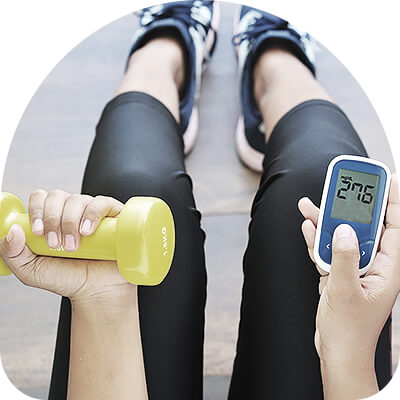Unraveling the Magic: How Exercise Lowers Blood Sugar
Exercise emerges as a formidable ally in the meticulous control of blood glucose levels, primarily through its dual-action mechanism that both stimulates glucose uptake into muscle cells and promotes enhanced insulin sensitivity. During physical activity, muscles consume glucose at an accelerated rate to meet the increased energy demand, effectively lowering blood sugar levels. This process occurs as contractions stimulate the translocation of glucose transporter type 4 (GLUT4) to the muscle cell surface, increasing glucose uptake independently of insulin. This physiological adaptation not only provides an immediate benefit during exercise but also contributes to longer-term blood sugar management.

Moreover, exercise induces improvements in insulin sensitivity, an effect that can persist for hours to days after physical activity. The mechanism behind this improvement lies in the enhanced signaling pathways that render cells more responsive to insulin, thereby facilitating more efficient glucose uptake from the bloodstream into the cells. Regular physical activity also mitigates inflammation and reduces adipose tissue, both of which are contributing factors to insulin resistance. Consequently, individuals with type 2 diabetes or those at risk can experience substantial benefits from incorporating exercise into their lifestyle, as it addresses both the symptomatic and underlying aspects of glucose dysregulation.
| Exercise Type | Benefits for Blood Sugar Control |
|---|---|
| Aerobic (e.g., walking, running) | Increases insulin sensitivity, enhances cardiovascular health, and promotes immediate glucose utilization. |
| Resistance (e.g., weight lifting) | Boosts muscle mass, leading to higher basal metabolic rates and improved glucose storage. |
| Flexibility & Balance (e.g., yoga, Tai Chi) | May reduce stress-induced blood sugar spikes and support overall well-being. |
Understanding the underlying biochemical and physiological responses to exercise provides valuable insights into its role in diabetes management. Importantly, individualized exercise programs that consider personal preferences, capabilities, and medical conditions are crucial to maximizing the benefits of physical activity while minimizing risks. Engaging in regular physical activity, therefore, represents a pivotal strategy in the non-pharmacological arsenal against diabetes, underpinning the importance of lifestyle modifications in the holistic management of this condition.
The Exercise Effect: Boosting Insulin Sensitivity
Embarking on regular physical activity instigates a cascade of metabolic events that significantly enhance the body's sensitivity to insulin, a critical factor in the management of diabetes. At the molecular level, exercise activates AMP-activated protein kinase (AMPK), a vital enzyme that plays a pivotal role in cellular energy homeostasis. As muscles contract during physical activity, AMPK is stimulated, facilitating glucose transport into the muscle cells independent of insulin. This mechanism effectively lowers blood glucose levels, demonstrating how physical activity directly mitigates the hallmark challenge of insulin resistance in individuals with diabetes. Furthermore, exercise-induced improvements in insulin sensitivity are augmented by the upregulation of glucose transporter type 4 (GLUT4) expression. This increment in GLUT4 enhances glucose uptake by muscles, further stabilizing blood glucose levels and providing a sustainable model for diabetes management through lifestyle modification.
The physiological benefits of enhanced insulin sensitivity extend beyond immediate glucose control, laying the foundation for long-term diabetes management. Improved insulin sensitivity reduces the demand on the pancreas to produce insulin, potentially preserving beta-cell function and delaying disease progression. This positive feedback loop, initiated by exercise, also decreases the risk of developing type 2 diabetes-related complications, such as cardiovascular diseases, by ameliorating lipid profiles and lowering blood pressure. The increased muscle mass from regular exercise further aids in improving metabolic health, as more muscle translates to a greater depot for glucose disposal, thus reducing hyperglycemic episodes. This dynamic interplay between exercise and insulin sensitivity underscores the power of physical activity as a cornerstone in diabetes management, reinforcing the importance of incorporating exercise into daily routines for individuals with diabetes.
However, the journey towards enhancing insulin sensitivity through exercise underscores the necessity of personalized and strategic exercise prescriptions. Given the variability in individual responses to different forms of exercise, tailoring the type, intensity, and duration of physical activity becomes paramount in maximizing therapeutic outcomes. A holistic approach, combining aerobic, resistance, and flexibility training, ensures a comprehensive impact on muscle glucose uptake and insulin sensitivity. Health professionals must guide patients with diabetes in developing an exercise plan that not only addresses glycemic control but also promotes overall well-being, marking exercise not just as a therapeutic tool but a cornerstone in the pursuit of enhanced quality of life.
The Weight Loss Win: Shaping Diabetes Management
Within the realm of diabetes management, weight reduction emerges as a pivotal strategy, intricately linked with exercise, for enhancing the effectiveness of diabetes control measures. This relationship between weight loss and diabetes control is underscored by the critical role of adipose tissue in modulating insulin sensitivity. Excessive adiposity, particularly in the abdominal region, is implicated in the development of insulin resistance, a hallmark of Type 2 diabetes. Through targeted physical activities, individuals can mobilize fat stores, thereby diminishing one key driver of glucose dysregulation.

Furthermore, the metabolic benefits of weight loss extend beyond mere improvements in insulin sensitivity. As adipose tissue diminishes, adipokines — cytokines produced by fat cells that can contribute to insulin resistance — decrease in circulation. This reduction is complemented by an increase in the secretion of muscle-derived myokines during exercise, which promote enhanced glucose uptake in muscle cells and improved endothelial function. These physiological changes coalesce to forge a more glucose-tolerant environment, instrumental in the long-term management of diabetes.
Implementing a regular exercise regimen as a component of diabetes management also leverages the metabolic advantages of increased muscle mass that accompanies weight loss through exercise. Muscle tissue is a voracious consumer of glucose, and its expansion enhances basal metabolic rate (BMR), leading to more efficient glucose utilization even during periods of rest. This synergy between exercise-induced weight loss and improved glucose metabolism creates a robust framework for individuals battling diabetes to not only manage their condition more effectively but also to mitigate potential complications associated with this chronic disease.
Aerobic Vs. Resistance Training: Tailoring Your Routine
When devising a fitness routine for diabetes management, it's crucial to understand the distinct benefits and mechanisms of both aerobic and resistance training. Aerobic exercises, such as brisk walking, cycling, and swimming, enhance cardiovascular health and increase the heart rate, facilitating glucose uptake by muscle cells and improving blood sugar levels over time. This type of exercise primarily burns fat and calories, aiding in weight management, a key factor in controlling diabetes. On the other hand, resistance training, which includes activities like weight lifting and body-weight exercises, strengthens muscles, bones, and joints. Beyond its role in building muscle mass, resistance training has been shown to enhance insulin sensitivity. This means that muscle cells are better able to utilize available insulin to take up glucose during and after activity, thereby reducing blood sugar levels.
The interplay between these two forms of exercise creates a comprehensive approach to diabetes management. For instance, while aerobic exercises lower blood sugar levels effectively in the short term, resistance training offers longer-term benefits by increasing muscle mass. Since muscle tissue consumes more glucose than fat tissue, building muscle mass through resistance exercises can lead to more significant improvements in blood glucose control over time. Moreover, combining both modalities offers synergistic effects, as aerobic workouts help shed excess fat, and resistance training builds muscle tissue, together optimizing glucose utilization and insulin sensitivity in the body.
To maximize the benefits of an exercise regimen in diabetes control, healthcare professionals often recommend a tailored approach that incorporates both aerobic and resistance training, adjusted according to each individual's health status, fitness level, and preferences. Starting with low-to-moderate-intensity exercises and gradually increasing the intensity and duration is advisable to avoid hypoglycemia, especially in those on insulin or certain diabetes medications. Regular consultations with healthcare providers can further personalize an exercise routine, ensuring safety and effectiveness in managing diabetes through physical activity.
Exercise Timing and Frequency: Maximizing Benefits
Navigating the realms of exercise scheduling for diabetes management requires a nuanced understanding of one’s body and the multifaceted ways in which physical activity impacts glucose metabolism. The synchronization of physical activity with one's circadian rhythm, or internal body clock, plays a pivotal role in enhancing the efficacy of workouts. Research delineates that engaging in aerobic exercises during the late afternoon or early evening optimizes blood glucose control, possibly owing to the natural fluctuations in insulin sensitivity and metabolic rates throughout the day. This period aligns with a peak in insulin sensitivity, thus facilitating a more pronounced decrease in blood glucose levels post-exercise. Conversely, resistance training, when conducted in the morning, has been shown to kickstart metabolism and improve glucose uptake throughout the day.
The frequency of one’s exercise regimen stands as a cornerstone in managing diabetes effectively. Consistency is key, with the American Diabetes Association recommending at least 150 minutes of moderate to vigorous aerobic activity per week, spread over at least three days, with no two consecutive days without activity. This approach not only aids in maintaining steady blood glucose levels but also circumvents the potential downfall in insulin sensitivity that might arise from prolonged physical inactivity. Furthermore, incorporating mini bouts of physical activities, such as brisk walking or stair climbing for 10 minutes post-meal, can wield significant benefits in controlling postprandial blood glucose spikes.
| Activity Type | Recommended Timing | Frequency |
|---|---|---|
| Aerobic Exercises | Afternoon/Early Evening | At least 3 times a week |
| Resistance Training | Morning | 2-3 times a week |
| Short Physical Activities (e.g., brisk walking) | Post-meal | Daily |
Adherence to these exercise prescriptions delineates a path towards maximized benefits in the realm of diabetes control. The intertwining of exercise timing and frequency conjures a regimented yet flexible framework that not only champions blood sugar management but also paves the way for an enhanced quality of life for individuals grappling with diabetes. The key lies in personalizing exercise routines to fit one's lifestyle, ensuring sustainable and effective diabetes management.
Overcoming Barriers: Staying Motivated in Diabetes Control
Embarking on a journey toward better diabetes management through exercise requires not only understanding its benefits but also overcoming the obstacles that may impede consistency and motivation. One prevalent hindrance is the sheer difficulty of incorporating a regular exercise regime into one’s daily life, particularly in the face of busy schedules and existing lifestyle habits. The science behind habit formation suggests that making small, incremental changes can significantly enhance the likelihood of long-term adherence to physical activity. By setting realistic goals and celebrating minor victories, individuals can harness the principles of positive reinforcement to fortify their commitment to exercise.
Another considerable barrier is the lack of immediate results, which can often lead to discouragement and a diminution in motivation. It’s crucial to appreciate the internal changes that are occurring—enhanced insulin sensitivity, improved cardiovascular health, and the slow but steady modulation of blood glucose levels are monumental victories in the management of diabetes. Educating oneself about these invisible yet impactful benefits can provide a source of motivation even when external changes seem negligible.
Furthermore, the physical and psychological challenges associated with diabetes can sometimes make exercise seem daunting. For individuals experiencing complications such as neuropathy or those grappling with the psychological toll of chronic illness management, finding the motivation to exercise requires support. This is where the role of healthcare professionals and support groups becomes indispensable. By offering tailored advice and emotional support, they can help demystify exercise, making it a more approachable and less intimidating component of diabetes management.
Finally, integrating variety into one’s exercise routine can combat monotony and reignite motivation. Exploring different forms of physical activity, from yoga and dancing to swimming and cycling, can provide a much-needed stimulus for both the body and mind. This diversification not only prevents boredom but also promotes a more holistic approach to physical fitness, catering to the body’s need for both aerobic and resistance training. By adopting a multifaceted approach to overcoming these barriers, individuals with diabetes can harness the full spectrum of exercise benefits, paving the way for enhanced control and an improved quality of life.
By: Dr. Shira Eytan










